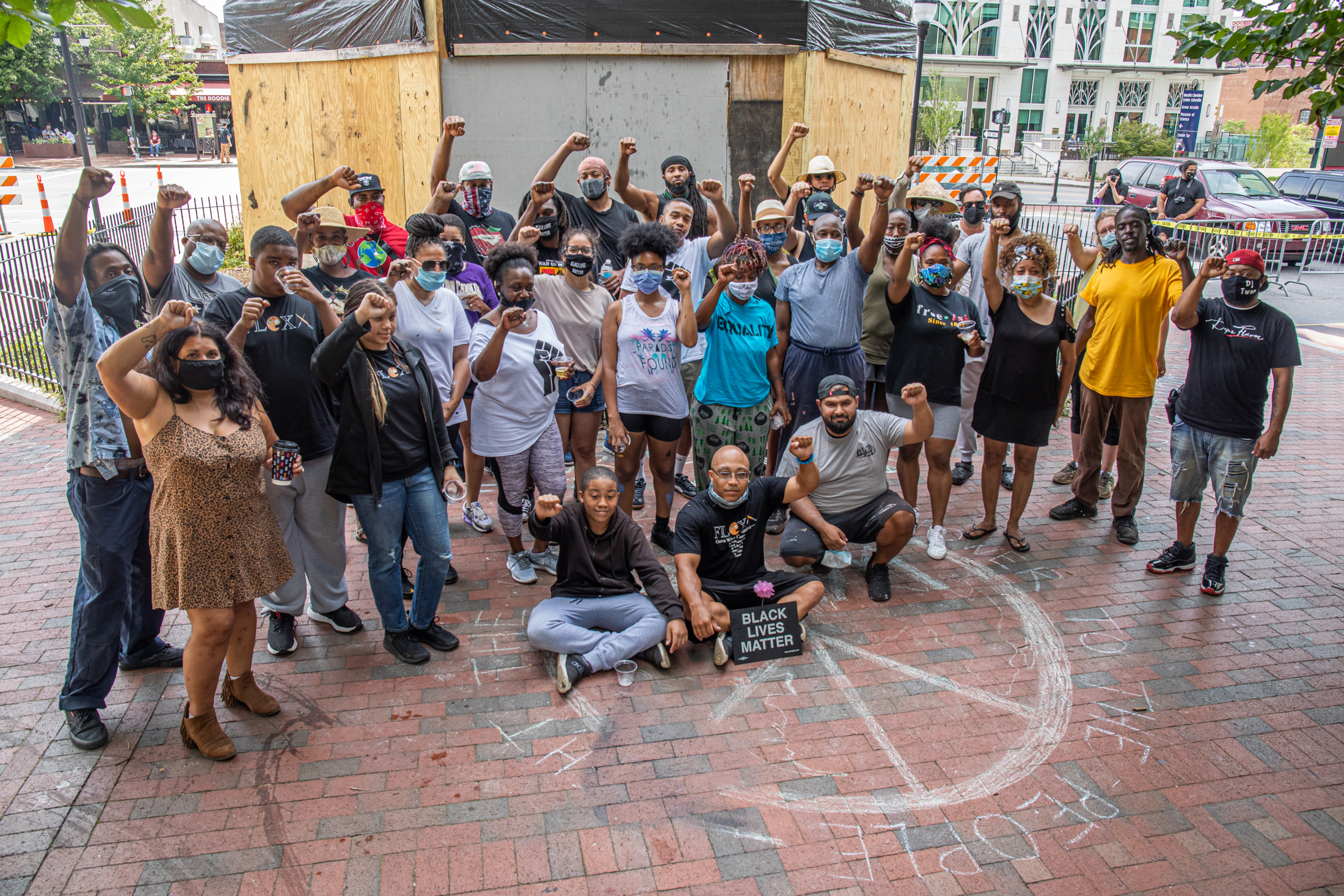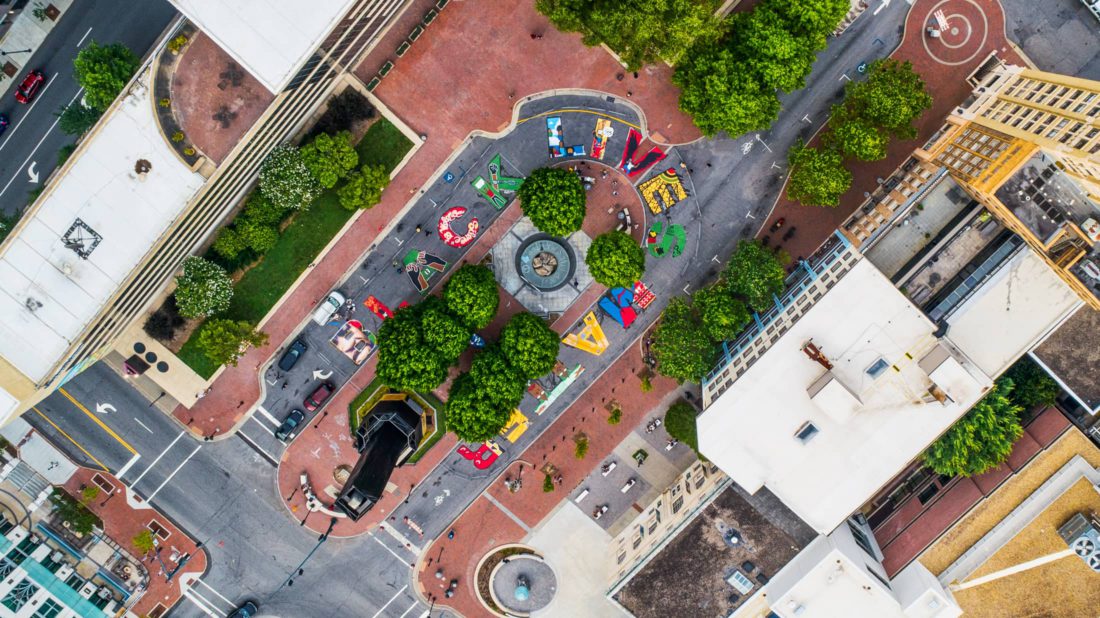The site of the Zebulon Vance Monument in the heart of downtown Asheville has long been a source of tribulation for the local Black community and its allies. Built near the spot where enslaved people were sold and traded, and honoring a Buncombe-born political leader who staunchly opposed abolition and equality, it’s served as a painful public reminder of prominent white supremacists and the lingering effects of centuries of racial oppression.
Now the same plot of land has transformed into one symbolizing unity as well as hope for true equality and lasting change. Since July 8, the obelisk has been shrouded from base to top and a city/county task force has been formed to prepare recommendations for altering or removing it. And on July 19, the arc-shaped street around the site became home to a Black Lives Matter mural, spearheaded by Asheville City Council member Sheneika Smith and Asheville Area Arts Council Executive Director Katie Cornell, that will be on display for a year.
Asheville-based artists Joseph Pearson and Jenny Pickens and former Western Carolina University professor Marie T. Cochran were chosen from a pool of applicants to be the project’s lead artists and were responsible for recruiting supporting artists to create and implement designs within the letters of their assigned word. Meeting twice via Zoom, the three agreed on having African nationalist colors of red, black and green, and shared basic sketches for what they had in mind for their sections of the mural. They then looped in collaborators to see their visions through — albeit with a significant dose of personal creative freedom.
At 2 a.m. on the day of the mural’s creation, WNC Landscaping pressure-washed the street, and prior to the artists arriving at 7 a.m., representatives from UNC Asheville’s STEAM Studio laid out the 15-foot by 15-foot stencils that had been created on their 3D printer. Though the lead artists and many of the supporting artists hadn’t previously met one another in person, they quickly began working as a concerted yet individualistic team, filling the letters with low-grade, environmentally friendly acrylic paint. A little before 5 p.m., a protective anti-graffiti layer was applied to the mural, and the artists, all of whom were paid for their efforts, took a look at their collective work.
Black
For each letter of the mural’s first word, Pearson made a basic sketch and let each of his artists choose how to express the concept. In starting the mural, he felt it was important that the face of slain Minneapolis resident George Floyd, whom he calls “the reason for the season,” be its primary image and selected Dustin Spagnola — who previously painted Floyd on the wood panels protecting the glass windows of Rosetta’s Kitchen — to carry it out.
“I knew he was the man for that job. There was nobody else,” Pearson says. “I don’t care who else is out there, there is nobody else who could do that but him. The work that he did — I just keep looking at it myself.”
With “L,” Jas Williams paid tribute to similar past protests, referencing U.S. sprinters John Carlos and Tommy Smith iconically raising their black-gloved hands on the medal podium at the 1968 Summer Olympics in Mexico City. “A,” painted by Autumn Nelson, finds black and brown hands intertwined with an Adinkra symbol that Pearson says “represents unity and human relationships,” while “C” features Ovidio Acevedo’s swirled cursive lettering of the phrase “Silence is violence,” which specifically places accountability on the three policemen who stood by and did nothing while Floyd lay dying.
As for “K,” realized by James Love, Pearson admits he “hadn’t quite resolved that one by the time we got to the project” but knew he “wanted someone with raised hands holding a protest sign.” Also part of the design are chains attached to another clenched fist — but with an open link at the bottom to symbolize freedom.
“Everything just went smoothly,” Pearson says. “Everybody came out knowing beforehand what was expected, knowing what to do and who would be doing what. And because of the cultural and historical significance of it, everybody was fully invested in making it a success and doing the best they could to see that that happened.”
Lives
Pickens, an Asheville native with family roots in the area, expressed a strong interest in designing the mural’s second word.
“It made me think of a history — what we originated from, the things we went through by being here and how we’re going to be progressing,” she says. “I sat up one night and I just started sketching and everything just came to me.”
For her crew, she selected personal artist friends who’d long discussed working together but had yet to have an opportunity arise. The exception was Cj Randall, who contacted Pickens about taking part. The two later discovered that they’d both crafted murals at the Arthur R. Edington Education & Career Center — Pickens in 2002 and Randall in 2016.
“Being from here and being an artist, there’s really not a lot of doors open for you because you don’t have that special training. And so I was saying to them, ‘It doesn’t require you to have to be in school. Some people are just naturally gifted,’” Pickens says. “I wanted to select people that needed that opportunity for that door to open for them — and nobody really knows them.”
The artists worked from Pickens’ sketches but had the freedom to put their own spins on the concepts. Michael Barnard, whom Pickens says is “good with faces,” handled the “L.” The lead letter features Black men and women in COVID-19 masks along with Floyd’s dying words, “I can’t breathe,” written at the bottom. Airbrush expert Walter Dickerson’s “I” originally had an elder, but Pickens changed it to reflect another unfortunately frequent saying: “Hands up! Don’t shoot!”
Randell’s “V,” the lone letter to turn out exactly as Pickens had originally drawn it, showcases a young Black boy who’s died and become an angel — and is also her personal favorite from her team’s work. Mixed media artist Beth Ivey filled the “E” with sun iconography, which was appropriately followed by Pickens’ son Timothy Davison’s “S” paying homage to Africa and the continent’s rich earth, with traditional symbolism reflecting a particular family’s stories.

Matter
In her capacity as founding curator of the Affrilachian Artist Project, Cochran organized a grassroots exhibition at the Haywood County Arts Council in February that featured the work of WCU arts school graduates LaKeisha Blount, Rahkie Mateen, Kela Hunt and Trey Miles. Once Cochran was named a lead artist on the Black Lives Matter mural, she pulled in those four colleagues, plus Athens, Ga.-based activist Broderick Flanigan and Sylva native Faustine “Tina” McDonald, whose design of blood cells in reference to her sickle cell anemia on the letter “R” perhaps best exemplifies Cochran’s goal for her collaborators.
“I had a clear vision of this imagery that I wanted, because I had handpicked these artists and, literally, I felt like, with the meaning being ‘Black Lives Matter,’ it was almost like I gave each of them a gift,” Cochran says. “Each of their letters had some kind of personal significance that they could draw from.”
Elsewhere, Blount’s “M” incorporates a mountain and imagery merging a quilt and kente cloth; Mateen’s “A” pays tribute to mountain arts, specifically the banjo’s African origins; and Flanigan’s “E,” the shape of which resembles railroad tracks, is filled with the legs and feet of Black youths, which Cochran notes symbolize “past and present aspirations of journeys and freedom.”
But it’s the two “T”s — the mural’s lone consecutively repeating letters — that Cochran feels are the key to her portion of the project. Enacted by college friends Hunt and Miles, the co-joined consonants feature twin figures of West Africa and an overarching color of green that represents land and money, with brown hands reaching toward the long-promised $20 bill with Harriet Tubman’s visage — the significance of which is not lost on Cochran in regard to the mural’s placement.
“It wasn’t just that it was the Vance Monument. It’s that it’s right in front of the Asheville Art Museum. And that’s not being irreverent for me, because back in February I was on other side of the glass. I was in the show Appalachia Now,” she says. “But even though I, as a first-generation college student who ended up being a college professor, know that I have the privilege of those degrees, one of the things we were chatting about is the fact that we were separated by the glass. It begs the question of African American presence and prominence in the arts. When are we going to change?”
With additional reporting by Thomas Calder




When do other political organizations get to advertise on city streets?
I would like to paint my street. Can I just do it or should I wait til the middle of the night?